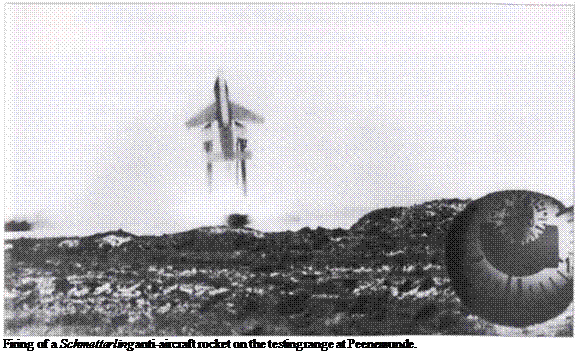Hs 117 Schmetterling

Initially it seemed that the Henschel designed Schmetterling had better prospects than other concepts. It was a subsonic, remote-controlled flak rocket with combined ailerons/rudder integral to the wings and was fired at a steep angle along a launch trailer on a light revolving chassis. Take-off was assisted by two solid-fuel boosters and a powerful liquid-fuel engine provided the cruising stage. After extensive research in 1942, Henschel received a contract for a pre-series ‘S’ in August 1943. The technical problems could not be overcome during that winter, and the first experimental rocket S V-l was first fired on 15 February 1944. Three of the first four starts that spring were failures. To put the development on a firmer footing, close cooperation developed between Henschel and the Askania, Bosch and Siemens companies. It was expected that 150 missiles would have to be fired to identify and eliminate all weaknesses before the project was ripe for series production.
An assessment in November 1944 on the launches so far reported that the small payload of S 1 had an effective destructive area which was too limited, but in the short term Schmetterling would be more effective than Wasserfall because the launch equipment was manoeuvrable. The RLM set great store by the fact that Schmetterling had a proven control system which would not require a long trial phase. By mid-November 1944 there had been 15 air launches from an He 111 H-6 for stability testing and flight attitude control while 21 were fired from the ground. The first two of these had no remote control; the others were fitted with a flight control unit.
On 21 December 1944, Oberst von Giildenfeldt of the Flakwaffe General Staff reported to the Chief-TLR that the first emplacements protecting armaments factories important for the war effort had been chosen for the Schmetterling. By the end of December 1944 another 23 Hs 117s had been produced; this was repeated in January 1945 and another 20 were planned for February, and after that nobody could predict because high-value raw materials for the envisaged series production were in very short supply.
Henschel was also planning an improved series version, the S 2, which resulted in three different and promising designs, S 2a, S 2b and S 2c. Despite the grave war situation, further Schmetterling testing continued. In test launches in January 1945, the rocket reached an altitude of 9,000 metres and had a range of 25 kilometres (30,000 ft/15 miles). Six more air launches followed at the beginning of February, and 38 from the ground. Only 28 of the 59 starts were satisfactory, in the others, as the report states, ‘some area of the rocket’ failed.
There were serious problems regarding the envisaged series run. The Chief – TLR War Diary entry for 21 January 1945 reports that BMW would not be able to supply engines for the Hs 117 on time. Delays of at least three months were anticipated. New variants such as the TV-guided Hs 117 H were cancelled on 6 February by Kammler, while all other designated work on the rocket had to be completed as soon as possible so that production of the basic S 1 design could follow at location B3 in the Harz. The war situation prevented the plans being realised, and the building work on the subterranean factory was abandoned in March 1945. The War Diary also indicates that the SG 45 solid-fuel engine for the Hs 117 was not supplied on time despite repeated reference to the Fiihrer’s standing order. More delays of at least three weeks ensued.
Mittelwerk was to house the production, and on 27 February the SS requested all relevant files from Henschel. A start date in March was not possible, however. On 13 March Himmler and the Dornberger team agreed a new date in May from when 300 Schmetterling would be produced monthly instead of the originally planned 3,000. The collapse in fuel production reduced fuel availability to one tenth the requested level. Once the rocket was deleted from the Fiihrer Emergency Programme, the series was downgraded on Himmler s order.
By 15 March only 140 rockets had been produced. Of these 80 were fired, but none operationally. The other 60 lacked a motor or parts of the remote-control equipment and were held back at the factory or test centres. After the Henschel development division relocated to the Harz in early 1945, development activity was resumed on a small scale and for a short time only in the incomplete underground complex at Himmelberg (B3a) at Woffleben. Meanwhile US armoured forces had advanced through the Harz, taking village after village with relatively little opposition. On 5 April rocket technicians in the Bad Sachsa-Bleichrode- Nordhausen area were shipped out to Upper Bavaria, where they ended the war. On 11 April US Special Forces captured Hs 117 parts in an underground gallery near Woffleben and these were spirited away to the United States before the arrival of the Soviet ally.










